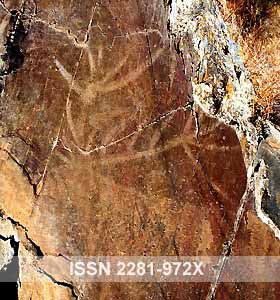 The paper by Daniel Castillo Benites from Peru and María Susana Barrau from Argentina (2016) offers an excellent overview regarding the rock art of the Virú drainage in northern Peru. Yet there are some flaws.
The paper by Daniel Castillo Benites from Peru and María Susana Barrau from Argentina (2016) offers an excellent overview regarding the rock art of the Virú drainage in northern Peru. Yet there are some flaws.
El trabajo de Daniel Castillo Benites (de Perú) y María Susana Barrau (de Argentina) (2016) ofrece una excelente visión general del arte rupestre en la cuenca del río Virú en el norte del Perú. Sin embargo, hay algunas fallas.
By Maarten van Hoek
*
*
Actualización del arte rupestre en la cuenca del río Virú, norte del Perú
Algunas observaciones sobre el artículo de Castillo-Barrau
*
Updating the rock art of the Virú drainage, northern Peru
Some observations regarding the Castillo-Barrau paper
Maarten van Hoek – rockart@home.nl
*
The paper by Daniel Castillo Benites from Peru and María Susana Barrau from Argentina (2016) offers an excellent overview regarding the rock art of the Virú drainage in northern Peru. As their paper is not available as a separate PDF on the internet, I enclose their paper in the PDF that is available at Academia. Yet there are some flaws.
El trabajo de Daniel Castillo Benites de Perú y María Susana Barrau de Argentina (2016) ofrece una excelente visión general del arte rupestre en la cuenca del río Virú en el norte del Perú. Como su artículo no está disponible como un PDF separado en el Internet, adjunto su documento en el PDF que es disponible en Academia. Sin embargo, hay algunas fallas.
Unfortunately, Castillo and Barrau fail to include or mention an important rock art site in the Virú Valley. In 2006 Elles and Maarten van Hoek recorded for the first time an extensive petroglyph site at Tomabal (actually three separate sites with altogether 38 decorated boulders) and in 2007 I published an article in the Boletín de SIARB, Bolivia, about Tomabal. It is remarkable that Castillo and Barrau overlooked this site and its publication, as I informed Castillo about our discovery. Details about Tomabal are available at my Academia web page where a PDF-copy of my paper can be downloaded: Please notice that I now disregard and for that reason do not use the term “Chavinoid” any longer, as I am convinced that the much earlier Cupisnique Culture is responsible for much of the rock art in the coastal area of northern Peru.
Desafortunadamente, Castillo y Barrau no incluyen ni mencionan un importante sitio de arte rupestre en el Valle de Virú. En 2006, Elles y Maarten van Hoek registraron por primera vez un extenso sitio de petroglifos en Tomabal (en realidad son tres sitios separados con un total de 38 rocas decoradas) y en 2007 publicé un artículo en el Boletín de SIARB, Bolivia, sobre Tomabal. Es notable que Castillo y Barrau pasaran por alto este sitio y la publicación, cuando informé a Castillo sobre nuestro descubrimiento. Los detalles acerca de Tomabal están disponibles en mi página web de Academia donde se puede descargar una copia en PDF de mi trabajo. Por favor note que ahora no tengo en cuenta y por eso no use el término “Chavinoides” ya que estoy convencido de que la cultura Cupisnique es responsable de gran parte del arte rupestre en la zona costera del norte del Perú.
Castillo and Barrau also do not consider another publication of a petroglyph boulder that I recorded for the first time in Virú (2014). It is moreover strange that they do not mention of the discoveries of archaeologist Thomas Zoubek near Huacapongo and Susanga.
Castillo y Barrau tampoco consideran otra publicación de una roca petróglifo que he encontrado por la primara vez en Virú (2014). Es extraño, además, que no mencionen los descubrimientos del arqueólogo Thomas Zoubek cerca de Huacapongo y Susanga.
A final observation concerns the fact that Elles and Maarten van Hoek discovered a new rock art site in the Virú drainage in September 2017. The location of this new site will not be revealed for the moment. Although it is a minor petroglyph site with at least five petroglyph boulders (and two possible examples), it still confirms the importance of the Virú drainage regarding rock art distribution.
Una observación final se refiere al hecho de que Elles y Maarten van Hoek descubrieron un nuevo sitio de arte rupestre en la cuenca del río Virú en septiembre de 2017. La ubicación de este nuevo sitio no se revelará por el momento. Aunque se trata de un sitio de petroglifos menor con al menos cinco rocas con petroglifos (y dos posibles ejemplos), aún confirma la importancia de la cuenca del río Virú en cuanto a distribución de arte rupestre.
References / Referencias
Castillo Benites, D. S. and M. S. Barrau. 2016. Avances en el inventario de sitios con arte rupestre en la cuenca del río Virú, La Libertad, Perú. Revista Arkinka. N° 252; pp. 100 – 111. Lima, Perú.
Van Hoek, M. 2007. Petroglifos Chavinoides cerca de Tomabal, Valle de Virú, Perú. BOLETÍN DE SIARB. Vol. 21; pp. 76 – 88. La Paz, Bolivia. Academia
Van Hoek, M. 2014. Reflecting (on) Petroglyphs: Two Cases. In: TRACCE – On-line Rock Art Bulletin.
Traducido con Google Translate
Disculpe los errores
Logo basado en Fig. 17 del artículo de Castillo y Barrau (2016)














Leave a Reply